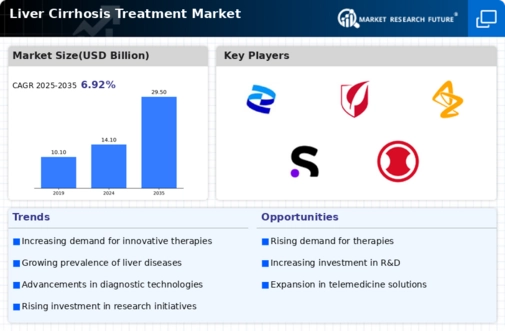Market Share
Liver Cirrhosis Treatment Market Share Analysis
Navigating the complex healthcare landscape demands strategic market share positioning strategies for companies operating within this space in relation to this condition's unique challenges. The first strategy involves specialized therapy development, while the second one is market segmentation, in which they cater specifically to various parts of the population suffering from liver cirrhosis. It should be noted that there are different causes responsible for different stages of liver cirrhosis, making a 'one-size-fits-all' approach ineffective. Thus, these companies strategically target specific patients with alcoholism-related cirrhosis or viral hepatitis-induced cirrhosis. A thorough understanding of various needs across such sections allows businesses to tailor their products so that they satisfy customer requirements better, thus securing firm positions within these limited markets." Liver cirrhosis treatment markets also employ market penetration strategies. Companies try to grow their market share by jumping into existing markets and expanding them. This involves a targeted marketing plan, competitive pricing, and an efficient distribution channel. In terms of the Liver Cirrhosis Treatment Market, working together with healthcare institutions and research organizations can have a large influence on market share positioning. Many companies come together to pool resources, expertise, and knowledge to accelerate the discovery of novel therapies. Special partnerships not only share important insights but also contribute to a culture that promotes collaboration for creative discovery. Collaboration among healthcare stakeholders, including pharmaceutical companies, medical professionals, and patient advocacy groups, is another driving force in the liver cirrhosis treatment market. Multi-disciplinary approaches involving hepatologists, gastroenterologists, and transplant surgeons are becoming increasingly common, ensuring comprehensive care for patients with liver cirrhosis. There must be a patient-centric approach if any company wants to position its product successfully within the Liver Cirrhosis Treatment Market. Companies that focus on understanding both patients' needs and challenges faced by healthcare providers can develop treatments and support services that really make a difference. Furthermore, this also involves expansion geographically, which is one of the strategies employed by companies in order to strengthen their position in the Liver Cirrhosis Treatment Market. Global prevalence rates and diverse healthcare infrastructures, therefore, necessitate strategic entry into new markets or increased presence in regions with a high burden of liver cirrhosis. Consequently, for example, products are being adapted so as to accommodate specific geographical locations, thereby enabling firms to reach out to a vast number of patients and increasing their proportion in respective markets.









Leave a Comment